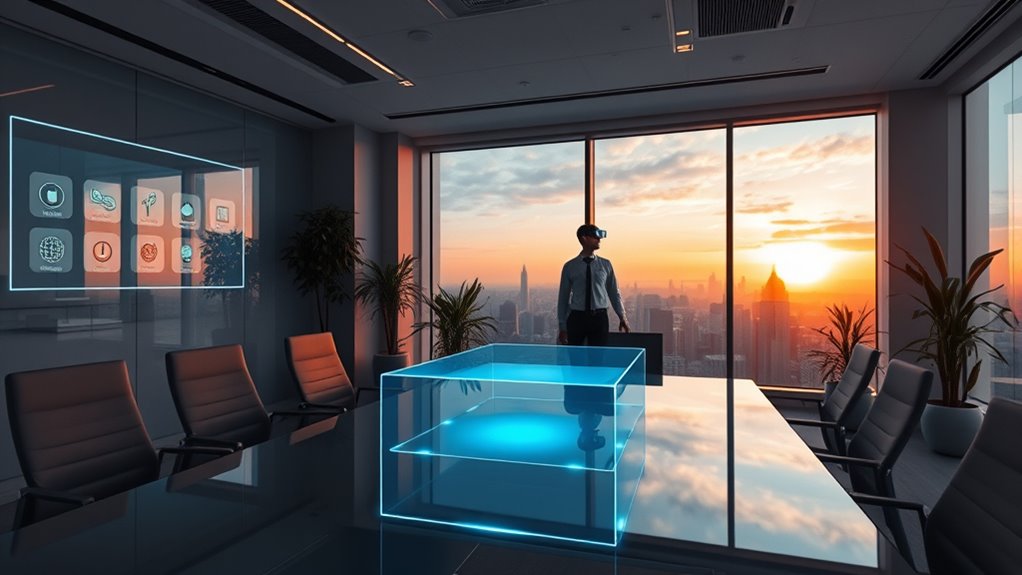The future of workspaces balances virtual and physical environments to boost productivity, collaboration, and well-being. You’ll find flexible spaces that easily adapt between collaborative areas and quiet zones, both at the office and at home. Digital tools will keep you connected in real time, while ergonomic designs support your health. By understanding these evolving settings, you can create a workspace tailored to your needs, fostering effectiveness and comfort. Keep exploring how this balance shapes your perfect work environment.
Key Takeaways
- Hybrid work models combine remote and in-office environments to enhance flexibility and meet diverse employee needs.
- Digital collaboration tools enable seamless real-time communication across physical distances, fostering teamwork.
- Physical workspace designs prioritize ergonomics and adaptability to support comfort, health, and spontaneous collaboration.
- Environments are evolving to balance virtual and physical elements, emphasizing human-centered design for well-being.
- Flexible layouts and organizational policies facilitate smooth transitions between virtual and physical workspaces, promoting productivity.

The future of workspaces is rapidly evolving as technological advancements and changing work habits reshape how and where we work. This shift isn’t just about switching from traditional offices to remote work; it’s about creating a seamless blend of virtual and physical environments that support productivity, well-being, and collaboration. As more people work from different locations, remote collaboration becomes the backbone of modern workspaces. You’ll find that effective communication tools, cloud-based platforms, and virtual meeting software are now essential for staying connected. These tools enable you to collaborate with colleagues in real-time, regardless of physical distance, fostering a sense of teamwork that transcends geography. The challenge lies in ensuring these digital interactions are smooth and engaging, which means designing spaces—both virtual and physical—that facilitate easy sharing of ideas and quick problem-solving.
At the same time, the physical workspace must adapt to these new demands by emphasizing ergonomic design. You’ll notice that companies are investing more in creating work environments that prioritize comfort and health, recognizing that well-designed ergonomic furniture and layouts reduce strain and fatigue. Sitting at a poorly designed desk all day can lead to discomfort, so adjustable chairs, sit-stand desks, and proper monitor placement aren’t just luxuries—they’re necessities for your well-being. Ergonomic design isn’t limited to furniture; it extends to the overall layout of the workspace, ensuring that movement is encouraged and that your posture remains healthy throughout the day. When your physical environment supports your body, you can focus better, work longer, and avoid common ailments like back pain or eye strain. Incorporating high refresh rates into displays can also improve visual comfort during extended periods of screen time.
As the lines between remote and in-office work blur, you’ll find that flexibility and intentional design are key. Hybrid work models demand environments that are adaptable, where you can switch seamlessly between collaborative spaces and quiet zones. In your home office, ergonomic considerations become even more critical because it’s where you spend significant hours. You might invest in adjustable lighting, supportive chairs, and desks that suit your height to create a productive yet comfortable space. Simultaneously, your organization will likely develop policies and tools that encourage effective remote collaboration, ensuring you stay connected and engaged no matter where you work from. This balanced approach ensures that workspaces evolve in a way that’s centered on human needs, fostering innovation and productivity while maintaining health and comfort.
Frequently Asked Questions
How Do Companies Measure Productivity in Hybrid Work Environments?
You measure productivity in hybrid work environments by tracking performance metrics like project completion rates, quality of work, and meeting deadlines. You also assess employee engagement through surveys, feedback, and participation levels. Combining these metrics helps you understand how well your team is performing and staying motivated across virtual and physical spaces, ensuring that productivity remains high regardless of where employees work.
What Technological Barriers Exist for Remote Workers Globally?
Imagine you’re stuck in a 90s dial-up world, and that’s how remote workers face technological barriers today. You encounter a digital divide, where limited internet access hampers productivity. Cybersecurity risks also loom large, making it tough to safeguard sensitive data. These barriers hinder global remote work, requiring investments in reliable connectivity and security measures to bridge gaps and ensure smooth, safe collaboration across borders.
How Will Office Design Evolve to Support Hybrid Models?
Office design will evolve with smart furniture that adapts to your needs, promoting comfort and flexibility in hybrid work. You’ll see more biophilic design, incorporating natural elements to boost well-being and focus. Spaces will blend technology with nature, making you feel connected yet relaxed, whether you’re in the office or remote. This balance supports productivity and health, ensuring your workspace caters to both collaboration and individual focus effectively.
What Legal Considerations Are There for Virtual Team Collaboration?
You need to guarantee data privacy and protect intellectual property when collaborating virtually. Implement secure platforms, use strong passwords, and encrypt sensitive information. Draft clear agreements outlining confidentiality and ownership rights to prevent disputes. Stay updated on legal regulations across jurisdictions, especially if team members are in different regions. Regular training on data security and IP protection helps your team avoid inadvertent breaches, keeping your virtual collaborations compliant and secure.
How Can Organizations Ensure Equitable Work Opportunities Remotely?
You can guarantee equitable work opportunities remotely by promoting digital inclusion and providing equitable access to technology and resources. Offer training programs, ensure your digital tools are accessible to all, and regularly assess your team’s needs. Encourage open communication to identify barriers, and implement flexible policies that support diverse work styles. This approach helps create an inclusive environment where everyone has a fair chance to succeed, regardless of their location.
Conclusion
Imagine walking through a vibrant office where sunlight streams through large windows, blending seamlessly with the hum of virtual collaboration on your headset. As you shift between the cozy corner of a physical workspace and the boundless digital world, you feel energized and connected. The future of workspaces is a harmonious dance between the tangible and the virtual—creating a space where innovation blooms and your productivity soars. Embrace this balance, and watch your workday become a seamless adventure.








